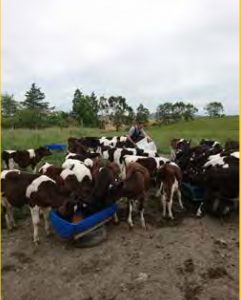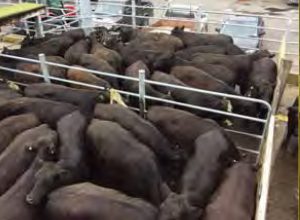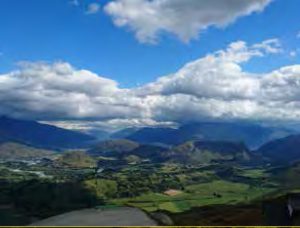I’ve recently returned from a sponsored study trip to New Zealand which I enrolled in through the Scottish association of young famers. On the tour were 20 curious young farmers looking to further their knowledge and understanding of agricultural production overseas.

It was evident that shortly after our arrival, the group as a whole were somewhat stunned and engrossed with not only the spectacular scenery, but the diversity and positive ‘gun ho’ attitude of the famers. Even in the wake of droughts and earthquakes. It was a fairly condensed trip visiting at least one different farm each day for the 2 week duration, and covering over 6000 kilometres. We saw an array of different systems including dairy, beef, arable, goats, pigs, deer, sheep, wool, seed production and veterinary.
To focus on the beef production.
New Zealand beef is largely a supply chain from high country hill famers who sell calves direct through an agent to lower ground farms for finishing.
If they have access to lower less acidic soils they are often finished on Lucerne if dry land, or a plantain/clover mix in warm wetter areas. Virtually nothing is housed or fed cereals at all. The majority of cattle are either Hereford or Aberdeen Angus. As these native breeds are bred to calf easily and fatten off grass efficiently.
Cows run with a bull for 6 weeks only, to retain fertility. Almost every farm will bull heifers to calf at 2 years old. And most calves will be weaned at just 150 days old (5 months) as research suggests a cows’ lactation will start to reduce at this point and the calf would be better off on a high protein diet. Also at this age the calves will start competing for grass and will always be second to their mothers. It is seen as very inefficient to leave a calf on its mother after this point as the cow does not need the good summer grass. When calves are weaned they are put onto high quality grazing in clean fertile pastures. The cows are put into high dry ground where they will be kept as cheaply as possible. Although to us UK farmers it sounds a low cost way to keep cows, the general feel was that the beef industry in New Zealand was being pressurised by the other sectors; dairy and sheep.

Firstly the price of beef is the same whether it comes from a beef breed or a dairy breed. There is no premium paid as it is not regarded as a quality product like British or Scotch Beef. Carcasses are not hung for more than a day; most of the beef packaged is for export. However there is a premium paid for the 5th quarter due to a strong demand from the Asian market.
Despite the recent crash the more recent rise, the dairy industry has been booming in New Zealand.
When price shot to $8/kg milk solids, at $4 cost of production it seems if your land could dairy, you did dairy. With mile after mile of black and white cows and irrigators the landscape changed, and still has its place even though margins have dropped considerably; with a price now about $5/kg milk solids. So dairy is the biggest industry, therefore rearing four day old ‘Bobby calves’ is a big industry. These calves can be bought far cheaper than beef calves, grow at a similar rate for finishing and provide a more secure investment for finishers. So in a sense they are under cutting the suckler beef calf market.
In some areas droughts are a major threat during their late summer months, January and February. But other than that, grass will grow the majority of the year making it paramount that it is utilised to its full potential. If a ewe weighing 60kg can rear 1.5 lambs at 30kg each she has weaned 75% of her body weight. If a 600kg cow rears a 280kg calf she has weaned less than 50% of her body weight. Therefore grazing sheep makes far better use of dry matter, allowing increasing stock units and production.

We visited Mount Linton Station in Southland in the later stage of the trip. Home to 40,000 breeding Romney cross ewes and 5,000 Angus cows. Other than its sheer scale this place did remind me of home. Rolling hills, summer time, damp and dreich!
Manager, Welshman Cerri Lewis took us up to 500m and assured us of how magical the view would be on a clear day, before telling us his approach at adding value to his cattle.
EBV’s were at the heart of his focus. His aim was to produce a high quality product and establish his own market. Eating quality was the direction to move in with grass fed cattle. And the way to monitor it was to measure intra muscular fat IMF. This shows how well marbled the beef is.
IMF is found by back scanning his heifers at 16months old to gather data for the Breedplan programme. Cerri said it’s encouraging to see how quickly and effectively this data is improving meat quality of his cattle. His policy is that all stock bulls used must have plus figures for IMF, also taking into account the other vital breeding values. Plus milk figures and plus 600 day weights were essential and a low mature weight was important to achieve a rapidly maturing animal that’s cheaper to keep.
An annual catalogue is made up of bulls being used and Bulls for sale from Mount Linton.
They sell over 300 breeding Bulls each year, most of which unseen, bought purely on EBV’s. And have established a premium market for high marbling grass fed beef.
So is marbled beef food for thought? Perhaps we should ask our consumers…
IAIN LIVESEY

THE ULTIMATE SUCKLER BREED
Previous slide
Next slide
IAIN LIVESEY – STUDY TOUR NZ
Facebook
Twitter
LinkedIn
Pinterest
Salers Cattle Society of the UK
Pepperwell, Castle Farm, Methven, PH1 3SU
T: 07903 626249
VAT Reg No: 625 3266 49
Registered Address: Lane Farm , Milnthorpe, LA7 7NH
T: 01539 567804
Company Reg No: 01892440 Charity No: 1115115
